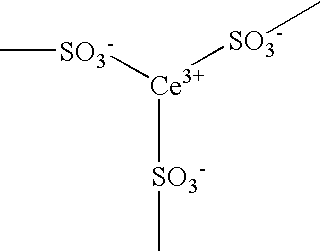Electrolyte membrane for polymer electrolyte fuel cell, process for its production and membrane-electrode assembly for polymer electrolyte fuel cell
a technology of electrolyte fuel cell and electrolyte membrane, which is applied in the direction of sustainable manufacturing/processing, conductors, final product manufacturing, etc., can solve the problems of poor stability against radicals, high cost, and poor durability, and achieve excellent durability, excellent resistance to hydrogen peroxide, and stably generating electric power over a long period of time
- Summary
- Abstract
- Description
- Claims
- Application Information
AI Technical Summary
Benefits of technology
Problems solved by technology
Method used
Image
Examples
example 1
[0046] 300 g of a CF2═CF2 / CF2═CFOCF2CF(CF3)O(CF2)2SO3H copolymer (ion exchange capacity: 1.1 meq / g dry polymer, hereinafter referred to as polymer A), 420 g of ethanol and 280 g of water were charged into a 2 L autoclave, sealed hermetically and mixed at 105° C. for 6 hours by means of a double helical blade to obtain a uniform liquid (hereinafter referred to as “liquid A”). The solid content concentration of the liquid A was 30 mass %.
[0047] 100 g of the liquid A and 0.5 g of cerium carbonate hydrate (Ce2(CO3)3.8H2O) were charged into a 300 mL round-bottomed flask made of glass and stirred at a room temperature for 8 hours by a meniscus blade made of PTFE (polytetrafluoroethylene). Bubbles due to generation of CO2 were generated from the start of stirring, and a uniform transparent liquid composition was finally obtained. The solid content concentration of the obtained liquid composition was 30.1 mass %. The composition was applied to a 100 μm ETFE (ethylenetetrafluoroethylene) sh...
example 2
[0054] 300 g of a CF2═CF2 / CF2═CFOCF2CF(CF3)O(CF2)2SO3H copolymer (ion exchange capacity: 1.24 meq / g dry polymer), 420 g of ethanol and 280 g of water were charged into a 2 L autoclave, sealed hermetically and mixed at 105° C. for 6 hours by means of a double helical blade to obtain a uniform liquid (hereinafter referred to as “liquid B”). The solid content concentration of the liquid B was 30 mass %.
[0055] 100 g of the liquid B and 0.5 g of cerium carbonate hydrate (Ce2(CO3)3.8H2O) were charged into a 300 mL round-bottomed flask made of glass and stirred at a room temperature for 8 hours by a meniscus blade made of PTFE. Bubbles due to generation of CO2 were generated from the start of stirring, and a uniform transparent liquid composition was finally obtained. The solid content concentration of the obtained liquid composition was 30.1 mass %. The composition was applied to a 100 μm ETFE sheet by cast coating with a die coater, preliminarily dried at 80° C. for 10 minutes and dried...
example 3
Comparative Example
[0058] Without adding any substance to the liquid A, an electrolyte membrane was obtained by cast coating. Except for using this electrolyte membrane, a membrane-catalyst layer assembly was obtained and a membrane-electrode assembly was further obtained in the same manner of Example 1. When the membrane-electrode assembly was evaluated in the same manner as in Example 1, the results as shown in Table 1 were obtained.
TABLE 1Output voltage ofoperation under lowOpen circuit voltage (V)humidification (V)After 100InitialInitialhoursEx. 10.720.970.94Ex. 20.750.980.95Ex. 30.760.960.75
PUM
| Property | Measurement | Unit |
|---|---|---|
| pressure | aaaaa | aaaaa |
| inner diameter | aaaaa | aaaaa |
| length | aaaaa | aaaaa |
Abstract
Description
Claims
Application Information
 Login to View More
Login to View More - R&D
- Intellectual Property
- Life Sciences
- Materials
- Tech Scout
- Unparalleled Data Quality
- Higher Quality Content
- 60% Fewer Hallucinations
Browse by: Latest US Patents, China's latest patents, Technical Efficacy Thesaurus, Application Domain, Technology Topic, Popular Technical Reports.
© 2025 PatSnap. All rights reserved.Legal|Privacy policy|Modern Slavery Act Transparency Statement|Sitemap|About US| Contact US: help@patsnap.com

